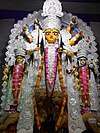Ratha Yatra
Ratha Jatra (/ˈrʌθə ˈjɑːtrə/), also referred to as Ratha Yatra or Chariot festival, is any public procession in a chariot.[1][2] The term particularly refers to the annual Rathajatra in Odisha, Jharkhand, West Bengal and other East Indian states, particularly the Odia festival[3] that involve a public procession with a chariot with deities Jagannath (Vishnu avatar), BalaBhadra (his brother), Subhadra (his sister) and Sudarshana Chakra (his weapon) on a ratha, a wooden deula-shaped chariot. It attracts over a million Hindu pilgrims who join the procession each year.[1][4]Rathayatra processions have been historically common in Vishnu-related (Jagannath, Rama, Krishna) traditions in Hinduism across India,[5] in Shiva-related traditions,[6] saints and goddesses in Nepal,[7] with Tirthankaras in Jainism,[8] as well as tribal folk religions found in the eastern states of India.[9] Notable ratha jatras in India include the Ratha jatra of Puri, the Dhamrai Ratha yatra and the Ratha yatra of Mahesh. Hindu communities outside India, such as in Singapore, celebrate Rathajatra such as those associated with Jagannath, Krishna, Shiva and Mariamman.[10] According to Knut Jacobsen, a Rathajatra has religious origins and meaning, but the events have a major community heritage, social sharing and cultural significance to the organizers and participants.[11]
Rathajatra are festival processions, occasions for religious, social and cultural celebrations. | |||||||
| Ratha Yatra | |
|---|---|
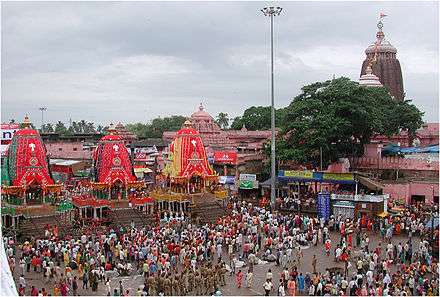 Three chariots of the deities with the Temple in the background, Puri | |
| Also called | Ghosa Jatra |
| Observed by | Hindu |
| Type | Religious |
| Begins | Ashadha Shukla Dwitiya |
| Ends | Ashadha Shukla Dashami |
| 2019 date | 4 July |
| 2020 date | 23 June |
| 2021 date | 12 July |
| 2022 date | 1 July |
| Frequency | annual |
Etymology
Ratha-jatra is derived two Sanskrit words, Ratha (रथ) which means chariot or carriage, and jātrā (यात्रा) which means journey or pilgrimage.[12] In other Indian languages such as Odia, the phonetic equivalents are used, such as ratha and yatra. Other names for the festival are ratha jatra or chariot festival.
Description
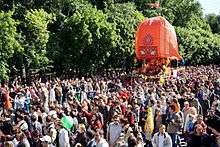
Rathajatra is a journey in a chariot accompanied by the public. It typically refers to a procession (journey) of deities, people dressed like deities, or simply religious saints and political leaders.[13] The term appears in medieval texts of India such as the Puranas, which mention the Rathajatra of Surya (Sun god), of Devi (Mother goddess), and of Vishnu. These chariot journeys have elaborate celebrations where the individuals or the deities come out of a temple accompanied by the public journeying with them through the Ksetra (region, streets) to another temple or to the river or the sea. Sometimes the festivities include returning to the sacrosanctum of the temple.[13][4]
Places
Jagannath Rath jatra at Puri (Odisha)
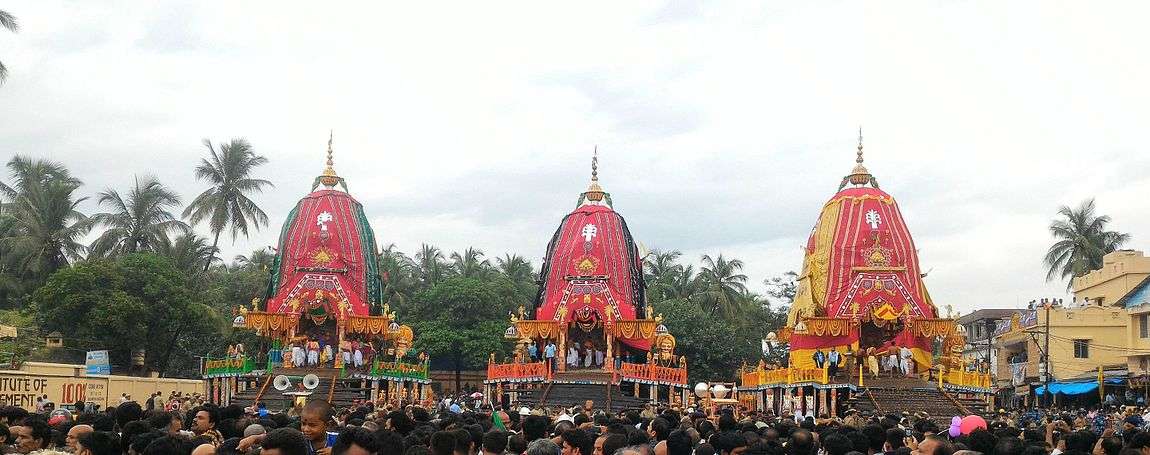
Triads are usually worshiped in the sanctum of the temple at Puri, but once during the month of Asadha (Rainy Season of Odisha, usually falling in month of June or July), they are brought out onto the Bada Danda (main street of Puri)[14] and travel (3 km) to the Shri Gundicha Temple, in huge chariots (ratha), allowing the public to have darśana (Holy view). This festival is known as Rath Jatra, meaning the journey (jatra) of the chariots (ratha). The Rathas are huge wheeled wooden structures, which are built anew every year and are pulled by the devotees. The chariot for Jagannath is approximately 45 feet high and 35 feet square and takes about 2 months to construct.[15] The artists and painters of Puri decorate the cars and paint flower petals and other designs on the wheels, the wood-carved charioteer and horses, and the inverted lotuses on the wall behind the throne.[16] The huge chariots of Jagannath pulled during Rath Jatra is the etymological origin of the English word Juggernaut.[17] The Ratha-Jatra is also termed as the Shri Gundicha jatra.
The most significant ritual associated with the Ratha-jatra is the chhera pahara. During the festival, the Gajapati King wears the outfit of a sweeper and sweeps all around the deities and chariots in the Chera Pahara (sweeping with water) ritual. The Gajapati King cleanses the road before the chariots with a gold-handled broom and sprinkles sandalwood water and powder with utmost devotion. As per the custom, although the Gajapati King has been considered the most exalted person in the Kalingan kingdom, he still renders the menial service to Jagannath. This ritual signified that under the lordship of Jagannath, there is no distinction between the powerful sovereign Gajapati King and the most humble devotee.[18]
Chera pahara is held on two days, on the first day of the Ratha Jatra, when the deities are taken to garden house at Mausi Maa Temple and again on the last day of the festival, when the deities are ceremoniously brought back to the Shri Mandir.
As per another ritual, when the deities are taken out from the Shri Mandir to the Chariots in Pahandi Vijay.
In the Ratha Jatra, the three deities are taken from the Jagannath Temple in the chariots to the Gundicha Temple, where they stay for nine days. Thereafter, the deities again ride the chariots back to Shri Mandir in bahuda Jatra. On the way back, the three chariots halt at the Mausi Maa Temple and the deities are offered Poda Pitha, a kind of baked cake which are generally consumed by the people of Odisha.
The observance of the Rath Jatra of Jagannath dates back to the period of the Puranas. Vivid descriptions of this festival are found in Brahma Purana, Padma Purana, and Skanda Purana. Kapila Samhita also refers to Rath Jatra. In Moghul period also, King Ramsingh of Jaipur, Rajasthan has been described as organizing the Rath Jatra in the 18th Century. In Odisha, Kings of Mayurbhanj and Parlakhemundi were organizing the Rath Jatra, though the most grand festival in terms of scale and popularity takes place at Puri.
Moreover, Starza[19] notes that the ruling Ganga dynasty instituted the Rath Jatra at the completion of the great temple around 1150 AD. This festival was one of those Hindu festivals that was reported to the Western world very early. Friar Odoric of Pordenone visited India in 1316–1318, some 20 years after Marco Polo had dictated the account of his travels while in a Genoese prison.[20] In his own account of 1321, Odoric reported how the people put the "idols" on chariots, and the King and Queen and all the people drew them from the "church" with song and music.[21] [22]
International Jagannath Ratha Jatra
The Ratha Jatra festival has become a common sight in most major cities of the world since 1968 through the Hare Krishna movement. Local chapters put on the festival annually in over a hundred cities worldwide.[23]
Dhamrai Jagannath Roth festival
Dhamrai Jagannath Rath is a chariot temple, a Roth, dedicated to the Hindu God Jagannath located in Dhamrai, Bangladesh. The annual Jagannath Roth Jatra is a famous Hindu festival attracting thousands of people. The Roth Jatra in Dhamrai is one of the most important events for the Hindu community of Bangladesh.[24] The original historical Roth was burnt down by the Pakistan Army in 1971[4] The Roth has since been rebuilt with Indian assistance.
Ratha Jatra of Mahesh
The Ratha Yatra of Mahesh is the second oldest chariot festival in India (after Rath Yatra at Puri) and oldest in Bengal,[25] having been celebrated since 1396 CE.[26] It is a month-long festival held at Mahesh in Serampore of West Bengal and a grand fair is held at that time. People throng to have a share in pulling the long ropes (Roshi) attached to the chariots of Lord Jagannath, Balarama and Subhadra on the journey from the temple to Gundicha Bari (Masir bari) and back.
Manipur
The practice of Ratha Yatra in Manipur was introduced in the nineteenth century. The Khaki Ngamba chronicle mentions that on a Monday in either April or May 1829, the King of Manipur Gambhir Singh was passing through Sylhet whilst on a British expedition against the Khasis. Two processions were being prepared by Sylhet's Muslim and Hindu communities respectively. The Islamic month of Muharram in the history of Sylhet was a lively time during which tazia processions were common. This happened to fall on the same day as Ratha Yatra. Sensing possible communal violence, the Faujdar of Sylhet, Ganar Khan, requested the Hindu community to delay their festival by one day. Contrary to the Nawab's statement, a riot emerged between the two communities. As a Hindu himself, Singh managed to defend the Hindus and disperse the Muslim rioters with his Manipuri troops. The Ratha Yatra was not delayed, and Singh stayed to take part in it. Revered by the Hindu community as a defender of their faith, he enjoyed the procession and initiated the practice of celebrating Ratha Yatra and worshipping Jagannath in his own homeland of Manipur.[27]
Examples

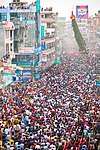
- Ratha-Jatra, Puri, at Puri in the state of Odisha, is the largest and most visited Rath Jatra in the world attracting a large crowd every year.
- Baripada Ratha Jatra is the second oldest in the world. So Baripada is also called as Dwitiya Shrikhetra or 2nd Puri. Ratha Jatra has been celebrated here since 1575 without any interruption.
- Rath Jatra of Kendujhar is the second largest Rath Jatra in the world. The Keonjhar Ratha (Chariot) - Nandighosh is the Tallest Ratha in the World.
- Rath Yatra (Ahmedabad) - Rath Jatra also takes place in Ahmedabad, Gujarat State, which is known to be the third largest in the world.[28]
- Sukinda Ratha Jatra in Odisha is also known to attract a large number of devotees.
- Dhamrai Jagannath Roth, at Dhamrai in Bangladesh, is the most famous Rath Yatra in Bangladesh.
- ISKCON Dhaka Ratha Jatra is the second famous Rath Yatra in Bangladesh.
- Rajbalhat Ratha Jatra, West Bengal, India.

- People of Bastar region observe Ratha jatra during Dussehara.[30][31]
- Radha Rani Rath Jatra, held at the Radha Madhav Dham temple near Austin, Texas, U.S.A.
- Rath jatra in Silicon Valley is organized at Golden Gate Park, San Francisco, California, USA
- Ratha jatra is celebrated in more than 108 cities around the world.
See also
- Jatra (Nepal) Nepal chariot processions
- Black Nazarene procession – annual Philippines procession where millions participate
- Infant Jesus of Prague – an image that is a part of annual processions in Christianity
- Macy's Thanksgiving Day Parade – one of the world's largest processions based on social and cultural themes
- Ta'zieh – ritual processions of mourning marked annually by Shia Muslims
- Ratha Yatra (Puri)
References
- Lavanya Vemsani (2016). Krishna in History, Thought, and Culture: An Encyclopedia of the Hindu Lord of Many Names. ABC-CLIO. p. 135. ISBN 978-1-61069-211-3.
- Christophe Jaffrelot (1999). The Hindu Nationalist Movement and Indian Politics: 1925 to the 1990s. Penguin Books. pp. 416–421. ISBN 978-0-14-024602-5.
- Peter J. Claus; Sarah Diamond; Margaret Ann Mills (2003). South Asian Folklore: An Encyclopedia : Afghanistan, Bangladesh, India, Nepal, Pakistan, Sri Lanka. Taylor & Francis. pp. 515–. ISBN 978-0-415-93919-5.
- Mandai, Paresh Chandra (2012). "Rathajatra". In Islam, Sirajul; Jamal, Ahmed A. (eds.). Banglapedia: National Encyclopedia of Bangladesh (Second ed.). Asiatic Society of Bangladesh.
- Bruce M. Sullivan (2001). The A to Z of Hinduism. Rowman & Littlefield. pp. 100, 166, 209. ISBN 978-0-8108-4070-6.
- Pratapaditya Pal; Stephen P. Huyler; John E. Cort; et al. (2016). Puja and Piety: Hindu, Jain, and Buddhist Art from the Indian Subcontinent. University of California Press. pp. 72–74 with Figures 23–25. ISBN 978-0-520-28847-8.
- J.P. Losty (2004). David M. Waterhouse (ed.). The Origins of Himalayan Studies: Brian Houghton Hodgson in Nepal and Darjeeling, 1820-1858. Routledge. pp. 93–94 with Figure 5.11. ISBN 978-0-415-31215-8.
- Virendra Kumar Sharma (2002). History of Jainism: With Special Reference to Mathurā. DK. p. 162. ISBN 978-81-246-0195-2.
- Ajit K. Singh (1982). Tribal Festivals of Bihar: A Functional Analysis. Concept. pp. 30–33.
- Vineeta Sinha (2008). Knut A. Jacobsen (ed.). South Asian Religions on Display: Religious Processions in South Asia and in the Diaspora. Routledge. pp. 159–174. ISBN 978-1-134-07459-4.
- Knut A. Jacobsen (2008). Knut A. Jacobsen (ed.). South Asian Religions on Display: Religious Processions in South Asia and in the Diaspora. Routledge. pp. 8–11, 200–201. ISBN 978-1-134-07459-4.
- Nori J. Muster (2013). Betrayal of the Spirit. University of Illinois Press. p. 38. ISBN 978-0-252-09499-6.
- Michaels; Cornelia Vogelsanger; Annette Wilke (1996). Wild Goddesses in India and Nepal: Proceedings of an International Symposium, Berne and Zurich, November 1994. P. Lang. pp. 270–285. ISBN 978-3-906756-04-2.
- "Hopes Of Puri Rath Yatra Dying Fast". Odisha Television. Retrieved 22 May 2020.
- Starza 1993, p. 16.
- Das 1982, p. 40.
- "Juggernaut-Definition and Meaning". Merriam Webster Dictionary. Retrieved 28 November 2012.
- Karan, Jajati (4 July 2008). "Lord Jagannath jatra to begin soon". IBN Live. Retrieved 28 November 2012.
- Starza 1993, p. 133.
- Mitter 1977, p. 10.
- Starza 1993, p. 129.
- Das 1982, p. 48.
- Festival of India
- "Rathajatra festival today". The New Nation, Dhaka – via HighBeam Research (subscription required) . 24 June 2009. Archived from the original on 24 September 2015. Retrieved 3 September 2012.
- "Rathayatra celebrated in West Bengal". The Hindu. 4 July 2008. Retrieved 18 October 2008.
- "Bengal celebrates Rathajatra festival". Monsters and Critics. 16 July 2007. Retrieved 18 October 2008.
- Singh, Moirangthem Kirti (1980). Religious Developments in Manipur in the 18th and 19th Centuries. Manipur State Kala Akademi. p. 165-166.
Gonarkhan
- "About Ahmedabad Rath Jatra : Jamalpur Jagannath Temple".
- Nabadwip Jagannath
- S Banerjee, Partha (2008). "Dussehra in Bastar -- a riot of colours - Economic Times". indiatimes.com. Retrieved 9 January 2013.
The Bastar royal family figures prominently in the script and the props include a huge chariot that is first built, then ritually 'stolen', and then again recovered and pulled ceremonially through the streets of Jagdalpur
- "Tribals celebrate unique Dussehra in Bastar - Oneindia News". news.oneindia.in. 2008. Retrieved 9 January 2013.
The another attraction of this 'tribal Dusshra', is a double-decked Rath (Chariot) with eight wheels and weighing about 30 tonnes.
Bibliography
| Wikimedia Commons has media related to Rath Yatra. |
- Das, J. P. (1982), Puri Paintings: the Chitrakara and his Work, New Delhi: Arnold Heinemann
- P. Mitter (1977). Much Maligned Monsters: A History of European Reactions to Indian Art. University of Chicago Press. ISBN 9780226532394.
- Starza, O. M. (1993), The Jagannatha Temple at Puri: Its Architecture, Art, and Cult, BRILL, ISBN 978-90-04-09673-8, retrieved 15 December 2012

.jpg)




